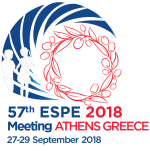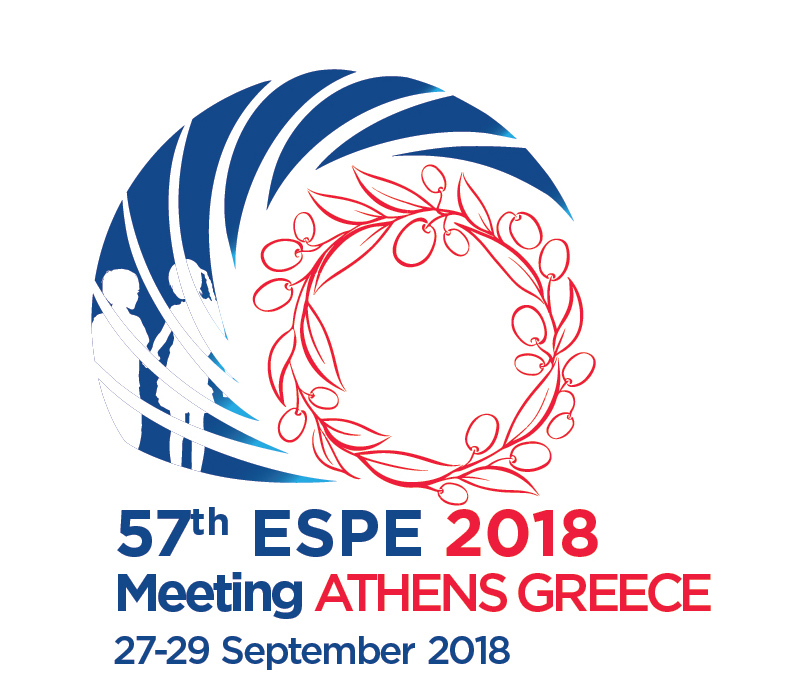
57th Annual ESPE
Athens,
Greece
27 Sep 2018 - 29 Sep 2018

Poster Presentations
Bone, Growth Plate & Mineral Metabolism P3
hrp0089p3-p031 | Bone, Growth Plate & Mineral Metabolism P3 | ESPE2018
Growth Hormone Treatment of 2 Patients with X-linked Hypophosphatemic Rickets Caused by PHEX Mutation: Effects on Linear Growth
Rojek Aleksandra , Obara-Moszynska Monika , Niedziela Marek
hrp0089p3-p032 | Bone, Growth Plate & Mineral Metabolism P3 | ESPE2018
A Novel Homozygous Mutation in the CASR Gene in a Neonate with Severe Primary Hyperparathyroidism; A Case Report
Alqadi Ali , Raboei Enaam , Ghafouri Abdullah , Alguthami Albandari , Alghanmi Razan
hrp0089p3-p033 | Bone, Growth Plate & Mineral Metabolism P3 | ESPE2018
A 13 Year-Old Boy Diagnosed as Osteogenesis Omperfecta with Normal Bone Mineral Density
Tınastepe Tuba , Filibeli Berna Eroğlu , Catlı Gonul , Dundar Bumin Nuri
hrp0089p3-p034 | Bone, Growth Plate & Mineral Metabolism P3 | ESPE2018
A Rare Cause of Hypercalcemia in Childhood: Hypercalcemia Associated with Parathormon-Related Peptid
Catlı Gonul , Filibeli Berna Eroğlu , Demir Belde Kasap , Mutlubaş Fatma , Dundar Bumin Nuri
hrp0089p3-p035 | Bone, Growth Plate & Mineral Metabolism P3 | ESPE2018
Our Treatment Experience with Nocturnal Continuous Enteral Calcium Infusion in a Case with Vitamin D Resistance Rickets Type II
Filibeli Berna Eroğlu , Kırbıyık Ozgur , Dundar Bumin Nuri
hrp0089p3-p036 | Bone, Growth Plate & Mineral Metabolism P3 | ESPE2018
A Novel COL1A2 Gene Mutation in a Turkish Family with Osteogenesis Imperfecta
hrp0089p3-p037 | Bone, Growth Plate & Mineral Metabolism P3 | ESPE2018
Hypophosphatemic Hypercalciuric Ricket: 3 Brothers with Dent’s Disease
Godoy Claudia , Grob Francisca , Gonzalez Gilberto , Vogel Andrea , Zambrano Pedro
hrp0089p3-p038 | Bone, Growth Plate & Mineral Metabolism P3 | ESPE2018
Infantile Hypophosphatasia
hrp0089p3-p039 | Bone, Growth Plate & Mineral Metabolism P3 | ESPE2018
Carbonic Anhydrase Deficiency: Three Siblings
Buluş Derya , Tayfur Aslı Celebi , Yılmaz Deniz
hrp0089p3-p040 | Bone, Growth Plate & Mineral Metabolism P3 | ESPE2018
A Novel p.Gly775Glu Missense COL1A2 Mutation Causes Severe Osteogenesis Imperfecta in a Prepubertal Girl
Kotanidou Eleni P , Doulgeraki Artemis , Costantini Alice , Makitie Outi , Athanasopoulou Helen , Laliotis Nikolaos , Galli-Tsinopoulou Assimina
hrp0089p3-p041 | Bone, Growth Plate & Mineral Metabolism P3 | ESPE2018
SHOX Gene Deletion Screening by FISH in Children with Short Stature and Characteristics of Patients
Kurnaz Erdal , Savaş-Erdeve Şenay , Cetinkaya Semra , Aycan Zehra
hrp0089p3-p042 | Bone, Growth Plate & Mineral Metabolism P3 | ESPE2018
Pseudoachondroplasia
Doğer Esra , Bideci Aysun , Boyunağa Oznur , Kılınc Uğurlu Aylin , Demet Akbaş Emine , Camurdan Orhun , Cinaz Peyami
hrp0089p3-p043 | Bone, Growth Plate & Mineral Metabolism P3 | ESPE2018
Low Level of Vitamin D in Children Increases the Risk of Bone Fractures
Nicolas Georges , Hoyek Fady , Assaf Elias , Abi Fares Georges , Akiki Simon
hrp0089p3-p044 | Bone, Growth Plate & Mineral Metabolism P3 | ESPE2018
Clinical Evaluation of Eight Patients with Parathyroid Adenoma
Direk Gul , Uzan Tatli Zeynep , Nur Hepokur Merve , Gul Şiraz Ulku , Akin Leyla , Hatipoğlu Nihal , Kendirci Mustafa , Kurtoğlu Selim
hrp0089p3-p045 | Bone, Growth Plate & Mineral Metabolism P3 | ESPE2018
Idiopathic Hypoparathyroidism in a 10 Year-Old Girl with Concomitant Epilepsy, Long Q-T Syndrome (LQTS), Pericarditis and Pneumonia
Borysewicz-Sańczyk Hanna , Sawicka Beata , Kiryluk Barbara , Szumowski Piotr , Allgrove Dr. Jeremy , Bossowski Artur
hrp0089p3-p046 | Bone, Growth Plate & Mineral Metabolism P3 | ESPE2018
The Level of the Vitamin D and Bone Mineral Density in Children with Obesity
Mikhno Hanna , Solntsava Anzhalika , Vasilieva Natalia , Dashkevich Helena
hrp0089p3-p047 | Bone, Growth Plate & Mineral Metabolism P3 | ESPE2018
Evaluation of Bone Mineral Density and Bone Metabolism Markers in Children Diagnosed as Celiac Disease
Nur Peltek Kendirci Havva , Comba Atakan , Demir Emre
hrp0089p3-p048 | Bone, Growth Plate & Mineral Metabolism P3 | ESPE2018
Comparison of Serum 25-Hydroxy Vitamin D Levels among Children & Adolescence with Attention Deficit Hyperactivity Disorder and Healthy Lranian People
hrp0089p3-p049 | Bone, Growth Plate & Mineral Metabolism P3 | ESPE2018
Evaluating the Effect of Zoledronic Acid on Treatment of Primary and Secondary Pediatric Osteoporosis at Children’s Hospital 1 in Vietnam
Huynh Loan , Tran Huyen , Nguyen Trung
hrp0089p3-p050 | Bone, Growth Plate & Mineral Metabolism P3 | ESPE2018
Hypocalcemia Secondary to Maternal Vitamin D Deficiency
hrp0089p3-p051 | Bone, Growth Plate & Mineral Metabolism P3 | ESPE2018
Clinical and Genetic Evaluations of Three Patients with Vitamin D Dependent Rickets Type 1A
Kulikova Kristina , Kolodkina Anna , Vasiliev Eugeny , Petrov Vasily , Tiulpakov Anatoly
hrp0089p3-p052 | Bone, Growth Plate & Mineral Metabolism P3 | ESPE2018
A Rare Case of Familial Hypocalcemia
Sozaeva Leila , Yanar Eda , Tiulpakov Anotoly , Kareva Maria , Orlova Elizaveta
hrp0089p3-p053 | Bone, Growth Plate & Mineral Metabolism P3 | ESPE2018
HDR Syndrome: A Case Report of Hypoparathyroidism, Hearing Loss and Renal Agenesis
Dimitrova-Mladenova Mihaela , Todorova Zdravka , Stefanova Elisaveta , Kostova Antoaneta , Yordanova Desislava , Miteva Polina , Rusinov Dimitar
hrp0089p3-p054 | Bone, Growth Plate & Mineral Metabolism P3 | ESPE2018
Growth in The Coeliac Disease of The Child
Bessahraoui Mimouna , Oussaleh Nassima
hrp0089p3-p055 | Bone, Growth Plate & Mineral Metabolism P3 | ESPE2018
The British OsteoNEcrosis Study: A Multi-centre Prospective Study
Amin Nadia , James Beki , Feltbower Richard , Mushtaq Talat , Kinsey Sally
hrp0089p3-p056 | Bone, Growth Plate & Mineral Metabolism P3 | ESPE2018
Response to Pamidronate Therapy and Pharmacogenetics in Patients with Osteogenesis Imperfecta
Selveindran Nalini M , Hong Janet YH , Nawawi Nadiah Mohd , Murad Nor Azian Abdul , Jamal Rahman , Latiff Zarina Abdul , Aziz Bilkis Banu Abd , Zakaria Syed Zulkifli Syed , Zain Fuziah Md , Rasat Rahmah
hrp0089p3-p057 | Bone, Growth Plate & Mineral Metabolism P3 | ESPE2018
Results of 22 Weeks of Burosumab Therapy in a Patient with Severe Bone Deformities due to XLH
Ruiz-Ocana Pablo , Roldan-Cano Virginia , Castellano-Mendoza Ana , Salazar-Oliva Patricia , Lechuga-Sancho Alfonso
hrp0089p3-p058 | Bone, Growth Plate & Mineral Metabolism P3 | ESPE2018
Severe Neonatal Hypercalcemia: A Challenging Case
Hashim Raihana , Prematilake Dilusha , Gunasekara Buddi , Suntharesan Jananie , Kollurage Udeni , Atapattu Navoda
hrp0089p3-p059 | Bone, Growth Plate & Mineral Metabolism P3 | ESPE2018
Assessment of Vitamin D Status in Healthy Pre-pubertal Egyptian Children
Hamza Rasha , Toeima Nadin , Hamed Amira
hrp0089p3-p060 | Bone, Growth Plate & Mineral Metabolism P3 | ESPE2018
Are Caucasian Children at Risk of Sub-optimal Vitamin D Levels?
Shrikhande Krutika , Liu Nancy , Thavakumar Sankavi , Kumar Yadlapalli
hrp0089p3-p061 | Bone, Growth Plate & Mineral Metabolism P3 | ESPE2018
Incidence Rate of Vitamin D Deficiency in 12-year Old Children in Japan
Koyama Satomi , Naganuma Junko , Kubota Takuo , Ozono Keiichi , Arisaka Osamu , Yoshihara Shigemi
hrp0089p3-p062 | Bone, Growth Plate & Mineral Metabolism P3 | ESPE2018
Idiopathic Juvenile Osteoporosis: Common Symptoms in an Uncommon Condition
Uppal Saurabh , Senniappan Senthil , Dharmaraj Poonam , Hughes David
hrp0089p3-p064 | Bone, Growth Plate & Mineral Metabolism P3 | ESPE2018
Hypercalcemia Associated with Increased Parathyroid Hormone-related Protein (PTHrP) in a Patient with Medulloblastoma Successfully Treated with Pamidronate
hrp0089p3-p065 | Bone, Growth Plate & Mineral Metabolism P3 | ESPE2018
A Novel Deletion Mutation in the GLUT 2 Gene in a Patient with Fanconi Bickel Syndrome
Noorian Shahab , Aghamahdi Fatemeh , Rad Samira Saee
hrp0089p3-p066 | Bone, Growth Plate & Mineral Metabolism P3 | ESPE2018
A Case of Turner Syndrome with Graves’ Disease and Primary Hyperparathyroidism
Nagaki Shigeru , Tachikawa Emiko , Obara Takao , Osawa Makiko , Nagata Satoru
hrp0089p3-p067 | Bone, Growth Plate & Mineral Metabolism P3 | ESPE2018
Neonatal Hypocalcemia Revealing a Malignant Osteopetrosis
Porquet-Bordes Valerie , Gohier Heloise , Lescure Sandra , Pasquet Marlene , Baunin Christiane , Gennero Isabelle , Tauber Maite , Salles Jean Pierre , Edouard Thomas
hrp0089p3-p068 | Bone, Growth Plate & Mineral Metabolism P3 | ESPE2018
Frontal Behavior Dysfunctions Revealing a Dramatic Progression of Complex Cranial Base Abnormalities in a Severe Osteogenesis Imperfecta
Porquet-Bordes Valerie , Grandgeorge Naia , Moulin Pierre , Cheuret Emmanuel , Boetto Sergio , Sales De Gauzy Jerome , Gennero Isabelle , Tauber Maite , Edouard Thomas , Salles Jean Pierre
hrp0089p3-p069 | Bone, Growth Plate & Mineral Metabolism P3 | ESPE2018
Ionized Calcium and 25-Hydroxyvitamin D3 in Children with Steroid-sensitive Nephrotic Syndrome
Abdelmeguid Yasmine Ashraf , Omar Omneya Magdy , Sharaki Ola Atef , Kersh Mahmoud Mohi El-Din El
hrp0089p3-p070 | Bone, Growth Plate & Mineral Metabolism P3 | ESPE2018



